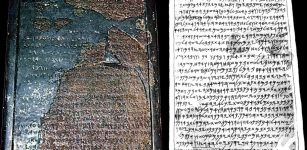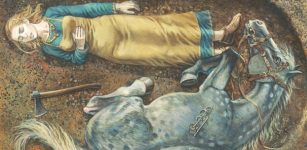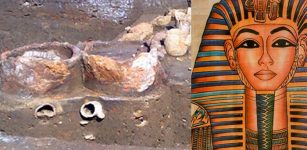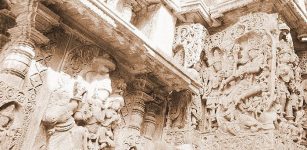Taweret – Powerful Egyptian Hippopotamus ‘Household Goddess’ Guarded Childbirth, House, Sleep And Dispelled Evil Forces
A. Sutherland - AncientPages.com - Attested since Old Kingdom times, Taweret (also known as Toeris, "great (female) one") is one of the Egyptian goddesses of fertility, especially focused on protecting women in childbirth and nursing small children.
Wooden sculpture of Queen Tiye, mother of Akhenaten and grandmother of Tutankhamun, in the form of Taweret, protector of women in childbirth. Image credit: Egyptian Museum, Turin.
She was a protector of the house, a guardian of sleep, and her amulets protected against evil charms.
Taweret was a popular divine figure, especially among the ancient Egyptian women who used to put an ivory wand on their stomachs to ask for her help during childbirth. The highly valued caring functions of the goddess were emphasized by making and using amulets depicting Taweret.
Along with her other counterparties, Taweret bore several epithets such as "Mistress of Pure Water," "Mistress of the Horizon," "She Who Removes Water," and "Lady of the Birth House." She also had many mythological associations, sometimes equated with Hathor as she was sometimes depicted in the underworld alongside Hathor, one of the most important goddesses of ancient Egypt. She also wears Hathor's headdress, a horned sun disk crown.
The monstrous appearance of Taweret
Taweret represented a fantastic animal, combining hippopotamus, crocodile, lion, and human.
It means Taweret had the head of a hippopotamus, a tail, lion (or human) hands hanging down loosely breast, a lion's legs, the swollen belly of a pregnant woman, and a crocodile ridge.
Faience statuette of Taweret (12cm) and faience amulets of Taweret (smallest = 2cm) in Glencairn Museum’s Egyptian collection. Source: https://glencairnmuseum.org
Taweret often wears a female wig decorated with a feathered headdress, which is also decorated with solar disks and horns.
The main attributes of this goddess are the "sa" symbol of protection. This ankh symbolizes life and the torch with the flame that usually gives light dispersing darkness and dispelling negative and hostile forces.
Her most unusual appearance survived in the form of amulets for more than 2000 years. Taweret's charms were famous among other cultures in the region of the Mediterranean and were finally introduced in Minoan Crete, where she was revered as a goddess of water, and
Cult of the goddess Taweret
Despite her considerable popularity among the so-called 'household deities,' Taweret is only depicted in some late temple scenes as a protective divinity and had no own cult sites.
Nevertheless, a large number of Taweret's images survived on many amulets, legs and backs of beds (especially women giving birth) and seats (especially for women), diverse head-rests, cosmetic, and other small furniture dated to (before 3100 BC) Old Kingdom times and onward.
In the Book of the Dead of Userhetmos, the dead woman is praying to Taweret and Hathor goddess of love (goddess of death in Thebes West) appears in cow shape from the western hill; 19th dynasty. Credit: Egyptian Museum, Cairo
Her cult dates back to the Pre-dynastic Period (before 3100 BC) when she was a significant goddess. Later, she lost her importance. Her role was surprisingly downgraded, and she became only a guardian demon, but in the Late Age (c. 664 BC – c. 332 BC), she was again a popular household deity.
So, Taweret (similar to Bes, protector of women and children and bringer of good luck.) was a contradictory figure, both protective and a terrifying demon.
A surprising discovery in Akhenaten's capital at el-Amarna
Excavations of the houses of Akhenaten's capital at el-Amarna revealed many amulets depicting Taweret and Bes and Taweret's images that decorated some of the Akhenaten's homes. Wall paintings depicting Taweret, Bes, and naked women (probably associated with childbirth rituals) were discovered at Deir el-Medina, in western Thebes.
Taweret was among other hippopotamus goddesses
Taweret is not the only hippopotamus goddess known in ancient Egypt. Others, such as Hedjet, Reret, and Ipet, were mainly worshiped in the region of Thebes. Their depictions showed a female hippotamus standing upright on legs, with the feet of a lion.
Another goddess was Ammit ("Eater of Hearts"), a female demon and goddess with a body that was a combination of lion and hippopotamus. Her head was that of a crocodile. Ammit was a resident of the Hall of Ma'at.
Taweret was associated with the northern skyscape in Egyptian astronomy and was usually referred to as the "Lady of Horizon."
Written by – A. Sutherland AncientPages.com Senior Staff Writer
Copyright © AncientPages.com All rights reserved. This material may not be published, broadcast, rewritten or redistributed in whole or part without the express written permission of AncientPages.com
Expand for referencesPinch G. Egyptian Mythology: A Guide to the Gods, Goddesses, and Traditions of Ancient Egypt
Budge, E Wallis (1904) The Gods of the Egyptians
More From Ancient Pages
-
 Ancient Nanotechnology Knowledge Inspired A Modern 3D-Printable ‘Lycurgus Cup’
Ancient Technology | Mar 13, 2019
Ancient Nanotechnology Knowledge Inspired A Modern 3D-Printable ‘Lycurgus Cup’
Ancient Technology | Mar 13, 2019 -
 Mysterious Deaths Around Empress Cixi – Cruel Tyrant Or Victim Of Propaganda?
Featured Stories | Apr 9, 2018
Mysterious Deaths Around Empress Cixi – Cruel Tyrant Or Victim Of Propaganda?
Featured Stories | Apr 9, 2018 -
 Mysterious Biblical Celestial City And Its Connection To The North Star – The Arrival – Part 2
Biblical Mysteries | Feb 26, 2021
Mysterious Biblical Celestial City And Its Connection To The North Star – The Arrival – Part 2
Biblical Mysteries | Feb 26, 2021 -
 Evidence Of Ancient Gigantic Tsunami That Struck Tel Dor Maritime City Mound, Israel
News | Jan 1, 2021
Evidence Of Ancient Gigantic Tsunami That Struck Tel Dor Maritime City Mound, Israel
News | Jan 1, 2021 -
 New Reading Of Mesha Stele And Consequences For Biblical History
Archaeology | May 2, 2019
New Reading Of Mesha Stele And Consequences For Biblical History
Archaeology | May 2, 2019 -
 Utiseta – Norse Vision Quest – Ancient Spiritual Tradition Of Northern Europe
Ancient Mysteries | Oct 3, 2019
Utiseta – Norse Vision Quest – Ancient Spiritual Tradition Of Northern Europe
Ancient Mysteries | Oct 3, 2019 -
 Surprising Discovery Of Nabataean Underwater Temple In Puteoli, Italy
Archaeology | Sep 23, 2024
Surprising Discovery Of Nabataean Underwater Temple In Puteoli, Italy
Archaeology | Sep 23, 2024 -
 On This Day In History: Foundation Stone Of The Royal Greenwich Observatory In London Was Laid – On August 10, 1675
News | Aug 10, 2016
On This Day In History: Foundation Stone Of The Royal Greenwich Observatory In London Was Laid – On August 10, 1675
News | Aug 10, 2016 -
 Forbidden Knowledge: Secret Ancient Gates Of The Shining Ones – The Beginning – Part 1
Ancient Mysteries | Jul 12, 2019
Forbidden Knowledge: Secret Ancient Gates Of The Shining Ones – The Beginning – Part 1
Ancient Mysteries | Jul 12, 2019 -
 8,000-Year-Old Petroglyphs Discovered In Oldest Impact Crater In South Africa
Archaeology | Jun 21, 2019
8,000-Year-Old Petroglyphs Discovered In Oldest Impact Crater In South Africa
Archaeology | Jun 21, 2019 -
 Olympe De Gouges – First French Feminist Challenged Maximilien de Robespierre And The Jacobins
Featured Stories | Nov 12, 2018
Olympe De Gouges – First French Feminist Challenged Maximilien de Robespierre And The Jacobins
Featured Stories | Nov 12, 2018 -
 Vikings Cared Deeply For Their Animal Companions – Shared Human And Horse Burials Reveal
Featured Stories | Aug 3, 2023
Vikings Cared Deeply For Their Animal Companions – Shared Human And Horse Burials Reveal
Featured Stories | Aug 3, 2023 -
 On This Day In History: The Lumière Brothers Presented Their First Film In Paris – On Dec 28, 1895
News | Dec 28, 2016
On This Day In History: The Lumière Brothers Presented Their First Film In Paris – On Dec 28, 1895
News | Dec 28, 2016 -
 Ancient Mystery Of The Man Mound And The Giant With Horns In Wisconsin
Featured Stories | Mar 1, 2021
Ancient Mystery Of The Man Mound And The Giant With Horns In Wisconsin
Featured Stories | Mar 1, 2021 -
 Recreation Of Cleopatra’s Ancient Perfume
Archaeology | Aug 26, 2019
Recreation Of Cleopatra’s Ancient Perfume
Archaeology | Aug 26, 2019 -
 Untold Story Of Mexico’s Ancient Giant Indians – Secret Knowledge Of The Aztecs Revealed – Part 1
Ancient Mysteries | Sep 21, 2019
Untold Story Of Mexico’s Ancient Giant Indians – Secret Knowledge Of The Aztecs Revealed – Part 1
Ancient Mysteries | Sep 21, 2019 -
 200,000-Year-Old Grass Bed Discovered In South Africa’s Border Cave
Archaeology | Aug 14, 2020
200,000-Year-Old Grass Bed Discovered In South Africa’s Border Cave
Archaeology | Aug 14, 2020 -
 Hoysaleswara Temple: Great Supporter Of Most Powerful Traditions Of Hinduism
Featured Stories | Jun 21, 2021
Hoysaleswara Temple: Great Supporter Of Most Powerful Traditions Of Hinduism
Featured Stories | Jun 21, 2021 -
 ‘Georgia Guidestones’: Bizarre Ominous And Strange Monument In North America
Featured Stories | Mar 27, 2022
‘Georgia Guidestones’: Bizarre Ominous And Strange Monument In North America
Featured Stories | Mar 27, 2022 -
 Why Were These People Buried In A Remote, Unmarked Grave In New Hampshire In The Mid-1800s?
Archaeology | Nov 4, 2024
Why Were These People Buried In A Remote, Unmarked Grave In New Hampshire In The Mid-1800s?
Archaeology | Nov 4, 2024



